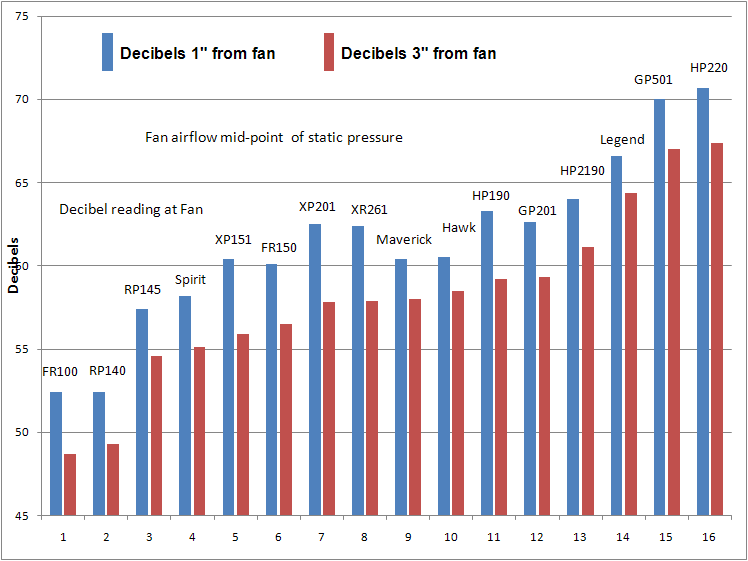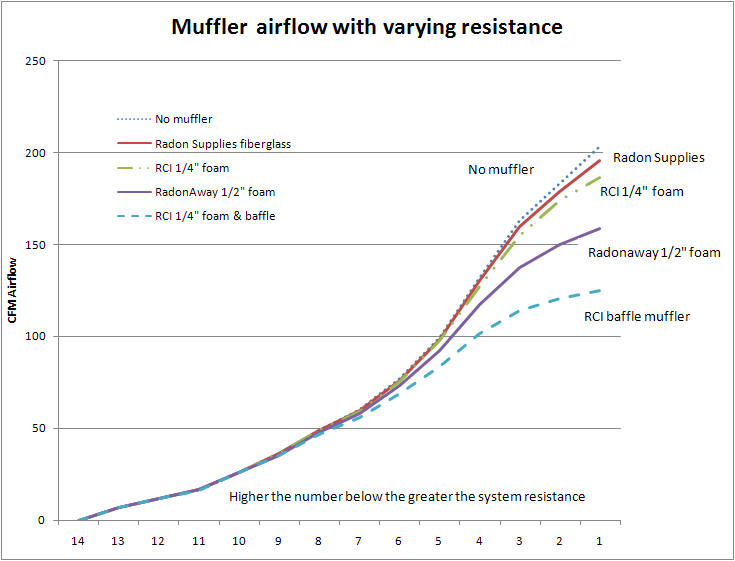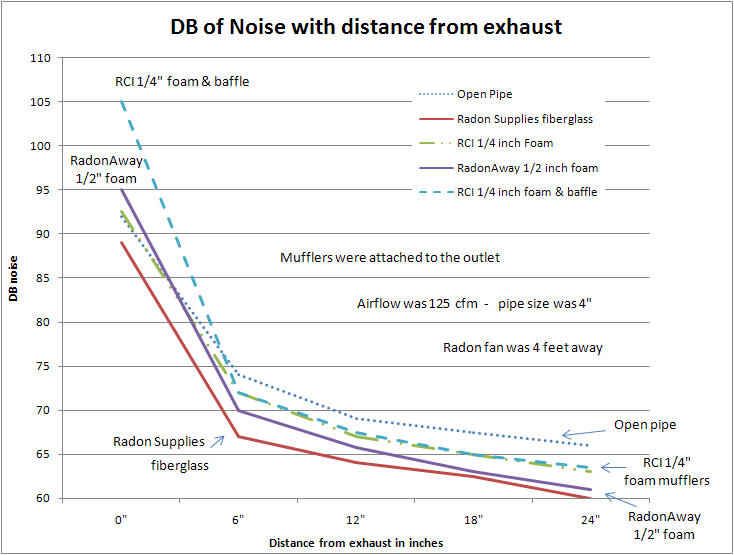How To Reduce Radon Fan Noise
The Noise Problem
There are a number of contributing factors with organization noise problems. Click underlined headings for more details below.
Fan Motor Dissonance - This is closely related to the fan wattage.
(Use a quieter fan or wrap the fan)
Fan induced vibration - This is due to improper fan blade residuum.
(Isolate piping from building components)
Air Flow Noise - Due to airflow speed through the piping or under membranes.
(Install muffler on exhaust - downsize pipe size - insulate pipes)
Competing Noise - What other noise is happening?
(Locate arrangement components where other noise is happening)
Occupant Distance from System - Where is system located?
(Locate organisation components away from occupied areas)
Occupant Sensitivity
(Ask occupants how important is noise reduction earlier installation)
Using a Quieter Fan or wrapping it with insulation
Radon fan motors vary considerably in the noise they generate. Often a fan with higher wattage than required is used because the installer does not mensurate the depressurization induced nether the slab. A lower wattage fan tin near always exist installed in standard radon sub-slab depressurization systems if at that place is skillful aggregate under the slab and the slab does non take big open up cracks or other unsealed openings. A 20 watt radon fan can save $500 in electrical cost over ten years and is considerably quieter. Visit the Radon Fan Performance page and look up your radon fan wattage. So check out the fans below. In general the lower the fan wattage the quieter the fan. These fans were tested with ten feet of piping and a muffler on the intake and exhaust to reduce this noise to a minimum. A sound meter was so held one" from the fan and iii" from the fan when the fan was operating at it's midpoint of it'due south operation curve.

Before installing a low wattage fan y'all should drill a pocket-size test hole (v/16" or 1/four") through the slab at the uttermost distance from the suction hole and measure the sub-slab negative pressure level under the slab. If you take greater than 5 pascals (0.020") negative pressure under the slab you should exist able to install a 20 watt fan without pregnant change to the radon reduction. The u-tube will generally read thirty% to 50% less. The 20 watt fans will easily pay for price of the fan in electrical savings in several years.
If the radon fan is located in the attic of the house or garage you can wrap the fan with fiberglass insulation. The air flowing through the fan will maintain the fan temperature. I have never establish a radon fan more than a scrap warm even if the motor has been stalled by some blockage then at that place appears to be no concern about causing a fire from the fan overheating.
goto pinnacle of page
Fan Induced Vibration
In that location is always some vibration occurring as the fan operates. The rubber boots used to adhere the fan to the pipe transfer lots of fan vibration. Place your hand on the fan. Then place you mitt on any building component that the piping above or below the fan is attached to. On exterior mounted fans feel the siding for vibration side by side to the first fan subclass above the fan and where the pipage enters the building. If the fan is in the cranium feel any framing that the fan is fastened to or the pipe rubs up confronting. If you feel whatsoever vibration of building components you can exist certain it is being transferred dorsum into the building. Feel the drywall inside the home that is closest to the fan location for vibration.
If the fan itself is touching any building components adjust the fan supports so it does not do this. You can also loosen or sometimes even remove the clamps that hold the piping above exterior mounted fans. Cheque for change in vibration transfer back into the building. If the vibration is less or gone and so determine if the support tin can be eliminated. If the supports are needed then try losely installing a cushion like fabric such equally closed jail cell cream capitalist rod betwixt the bracket and the pipe.
Occasionally during the system installation or after the organization has been running something sticks to the fan blades causing an increased vibration. Ofttimes bugs and debris accumulates on fan blades. Loosen the prophylactic boots holding the fan to the arrangement pipe and remove the fan. Carefully inspect the blades and scrap them clean with a screwdriver blade or other tool. Shake the fan and run it to clear out any debris in the fan. Be careful not to suck more debris in, particularly fingers.
If you lot bench test a dozen identical radon fans every bit I have, you will detect they vary in the amount of vibration. Some radon fans have small-scale clips placed on the fan blades. You tin can try by trial and error to adjust the clip to the next or previous bract and run the fan to decide if information technology is getting better or worse. Be certain to mark the original location of the clip.
goto top of page
Air Flow Noise
Fan systems installed outside should not be audible inside unless there is an next window that the occupants occassionally open and they spend time nearly to. This noise would be from both airflow and the fan. A lower wattage fan would exist the all-time solution. If the noise transfer is through an open second floor window then it is likely to be the piping airflow noise and the exhaust noise. The exhaust piping could be switched to thicker walled PVC piping or even a muffler on the frazzle stack if aesthetics is not a concern.
PIPE THICKNESS: Radon PVC piping is either one/8 inch walled schedule xx also known as sewer and bleed (S&D) or 1/iv" walled schedule twoscore DVW or schedule forty foamcore pipage. Using thicker walled pipe, especially the foamcore, will partially reduce airflow dissonance transmission.
SYSTEMS ROUTED THROUGH CLOSETS: If the house has a single floor section (ranch style) the system can be piped up through a closet to the attic. Avoid using a master bedroom closet. A hall closet is the all-time choice for minimal noise impact.
INSULATING THE Pipe: Piping that is routed through a space that needs to minimize airflow noise can exist insulated for noise reduction. Sliding the adjacent size larger flexible insulated duct over the pipe in the surface area that needs to have quieter pipe can be very effective. Using closed prison cell cream or thicker walled piping is less constructive.
Clamber SPACE MEMBRANES: If the home has a dirt floor crawl infinite the airflow dissonance from a sub-membrane suction organisation can sometimes be aural in the living area to a higher place the crawl space. Open confront fiberglass insulation tin be placed on top of the membrane or in the joist cavities above the suction location to dampen the dissonance. The smaller the pipe size drawing air from under the membrane the quieter the air menstruation noise. To reduce sub-membrane noise, downsize the pipe under the membrane to a ii" pipe which can move upwardly to 50 cfm or a i.5 inch pipage that tin move up to 35 cfm of air.
ROUTING NEW Structure Pipe: The air moving through a radon pipe has enough noise to be carried through drywall. Try to not route new construction passive radon pipes through walls next to a bedroom, especially the chief chamber. Builders rarely call up almost this detail. If yous can hear air menstruation racket through the drywall your just partial solution is installing a lower wattage fan in the attic. If information technology is really bothersome to the owner the arrangement may demand to be re-piped up the outside of the home.
EXHAUST MUFFLERS: Companies that supply radon products manufacturer different mode air catamenia mufflers. Some of the mufflers restrict the airflow at higher airflow speeds. This would just affect high airflow systems. Their effectiveness for dissonance reduction too varies. In full general a muffler volition not reduce the airflow noise coming from the pipage or the fan dissonance itself. The mufflers volition however lower the frazzle noise if they are placed near the exhaust port. The bodily noise reduction is moderate but the audio pitch is lowered which makes the noise less offensive. Organisation frazzle racket is usually only bothersome if the exhaust is at the get-go floor roof and the exhaust pipe is visible from a location that is frequently occupied. A 2d floor window that looks at a radon exhaust pipe on the garage roof or an exhaust out of a ranch roof that is visible from a rear deck would be good canidates for a muffler. The all-time muffler noise reduction is with the muffler installed on the end of the exhaust pipe with no chimney cap so that air catamenia is straight up. We accept installed the muffler on the exhaust port on the roof for maximum dissonance reduction even though it looks a bit out of identify.

This chart below
shows there is increasing resistance to airflow for some mufflers when the organisation airflow is above 50 cfm.


This next chart
depicts the actual measured sound in decibels (db) made using an Extech Audio Level Meter #407740. The airflow was 125 cfm for each measurement made. Each muffler was installed on the outlet of the pipe with the fan motor iv feet downstream and the system intake xiv feet away. The intake had a split up muffler attached to minimize the noise interference from this source. Notation that although the db reduction was small-scale each muffler lowered the pitch of the audio.


Hither are some pictures of the mufflers currently offered for auction.
Source: https://www.wpb-radon.com/Radon_fan_noise.html

0 Response to "How To Reduce Radon Fan Noise"
Post a Comment